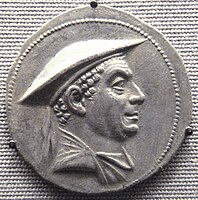Cybersecurity and privacy risk assessment of point-of-care systems in healthcare: A use case approach
Contents
The kausia or causia (Ancient Greek: καυσία[1]) was an ancient Macedonian flat hat. A purple kausia with a diadem was worn by the Macedonian kings as part of the royal costume.[2]
Name
The name is derived from its keeping off the heat (καῦσις).[2]
Background
It was worn during the Hellenistic period but perhaps even before the time of Alexander the Great[3] and was later used as a protection against the sun by the poorer classes in Rome.[4]
Depictions of the kausia can be found on a variety of coins and statues found from the Mediterranean to the Greco-Bactrian kingdom and the Indo-Greeks in northwestern India. The Persians referred to both the Macedonians and the rest of the Greeks as "Yauna" (Ionians), but made a distinction between "Yauna by the sea" and those "with hats that look like shields" (yauna takabara), probably referring to the Macedonian kausia hat.[5] According to Bonnie Kingsley the kausia may have came to the Mediterranean as a campaign hat worn by Alexander and veterans of his campaigns in the Indus[6] but according to Ernst Fredricksmeyer the kausia was too established a staple of the Macedonian wardrobe for it to have been imported from Asia to Macedonia.[7]
A modern descendant of the hat may be the Pakol: the familiar and remarkably similar men's hat from Pakistan, Afghanistan and Jammu and Kashmir.[8]
Gallery
-
Ancient Macedonian soldiers, from the tomb of Agios Athanasios (Greece) wearing the kausia (grave of Agios Athanasios, 4th century BC
-
Coin of Greco-Bactrian king Antimachus I Theos wearing the Macedonian kausia, c.185–170 BC
-
Antigonus II Gonatas wearing the kausia and holding a spear, detail of a fresco in Villa Fannius, c. 40 BC, Archaeological Museum of Naples
See also
References
- ^ Henry George Liddell; Robert Scott. "καυσία". A Greek-English Lexicon – via Perseus.
- ^ a b Harry Thurston Peck, Harpers Dictionary of Classical Antiquities (1898), Causia
 This article incorporates text from this source, which is in the public domain.
This article incorporates text from this source, which is in the public domain.
- ^ Kingsley, Bonnie M. (1984). "The Kausia Diadematophoros". American Journal of Archaeology. 88 (1): 66–68. doi:10.2307/504602. JSTOR 504602. S2CID 193037990.
- ^ Miles gloriosus. Harvard University Press. 1997. ISBN 9780674574373.
- ^ Roisman, Joseph; Worthington, Ian (2010). A Companion to Ancient Macedonia. John Wiley and Sons. p. 87. ISBN 978-1-4051-7936-2.
- ^ Kingsley, Bonnie M. (1981). The Cap That Survived Alexander. Vol. 85. p. 39.
{{cite book}}:|work=ignored (help) - ^ Fredricksmeyer, Ernst (1986). Alexander the Great and the Macedonian kausia. Vol. 116. pp. 215–227.
{{cite book}}:|work=ignored (help) - ^ Worthington, Ian; Geoffrey, Nicholas; Hammond, Lemprière (1994). Ventures into Greek history. Clarendon Press. p. 135. ISBN 978-0198149286.
External links
 Media related to Kausia at Wikimedia Commons
Media related to Kausia at Wikimedia Commons























